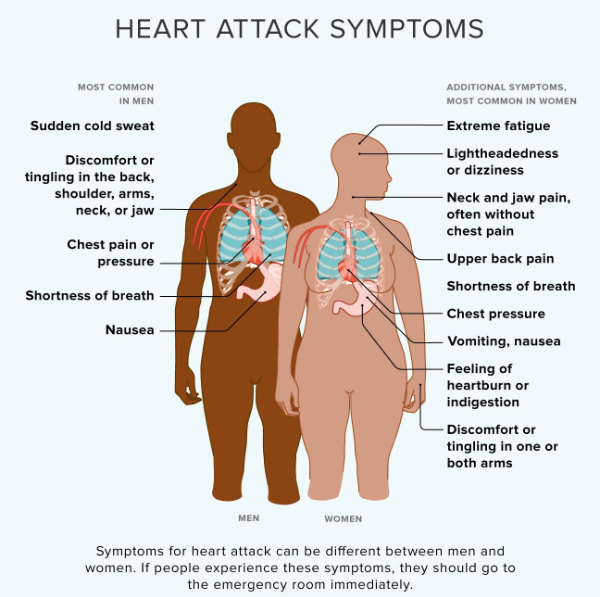A heart attack happens when blood flow to the heart is blocked. Like males, females often experience chest pain or tightness. However, they may feel pain in other body parts.
A heart attack can cause various symptoms, which may develop suddenly or gradually over hours, days, or weeks.
According to The Heart Foundation, while chest pain or discomfort is the most common symptom of a heart attack, it doesn’t always develop, especially in females.
Females may be more likely than males to experience other symptoms of heart attack, report researchers from the American College of Cardiology (ACC) and American Heart Association (AHA).
Read on to learn more about the symptoms of heart attack in females and males.
Are sex and gender the same thing?
People often use the terms sex and gender interchangeably, but they have different meanings:
- “Sex” refers to the physical characteristics that differentiate male, female, and intersex bodies.
- “Gender” refers to a person’s identity and how they feel inside. Examples include man, woman, nonbinary, agender, bigender, genderfluid, pangender, and trans. A person’s gender identity may be different from the sex they were assigned at birth.
Heart attack symptoms in women
The most common symptom of a heart attack in females is chest pain or discomfort. This may feel like pain, tightness, pressure, squeezing, or heartburn. It typically lasts for more than a few minutes or comes and goes.
During a heart attack, it’s also common for females to have pain or discomfort in one or more of the following areas:
- jaw
- neck
- upper or lower back
- shoulders
- arm
- abdomen
Other common symptoms in females

Other common symptoms of heart attack in females include:
- shortness of breath
- nausea, vomiting
- lightheadedness, dizziness, fainting
- cold sweats
Heart attack may also cause:
- fatigue
- trouble sleeping
- general weakness
- unusually fast or slow heart rate
- palpitations, or a fluttering or pounding heart
- anxiety or fear
Shoulder pain from heart attack
Although heart attack is most commonly associated with chest pain, it can also cause pain or discomfort in other parts of the body, including the shoulder.
Both females and males may experience shoulder pain during a heart attack. Some research suggests shoulder pain during a heart attack may be more common in females than men.
A 2018 study looked at 532 people who had an ST-elevation myocardial infarction (STEMI), a type of heart attack that affects the whole heart muscle wall. Shoulder pain was twice as common in females than men. Throat and back pain were also more common in females.
Heart attack symptoms in women vs. men

Heart attack in males usually causes chest pain or discomfort, which may feel like pain, heaviness, pressure, fullness, squeezing, or heartburn. It typically lasts for more than a few minutes or goes away but returns again.
Common symptoms in males
Another common symptom of heart attack in males is pain or discomfort in one or more of the following areas:
- jaw
- neck
- upper back
- shoulders
- arm
- abdomen
Heart attack in males may also cause shortness of breath.
Less common symptoms
Less common symptoms in males include:
- fatigue
- nausea, vomiting
- unusually fast or slow heart rate
- dizziness, lightheadedness, or fainting
- palpitations, or a fluttering or pounding heart
- cold sweats
Risk factors of heart attack in women
Risk factors for heart attack can apply to both females and men. These include factors like family history, diet, and lack of physical activity.
According to researchers in a 2017 reviewTrusted Source, females ages 18 to 55 have a higher rate of certain medical conditions that may increase their risk of a heart attack.
Some of these conditions include:
- chronic obstructive pulmonary disease (COPD)
- kidney failure
- autoimmune conditions
- cancer
- mental health conditions
Certain risk factors that apply to both males and females may be experienced differently by females, such as:
- High blood pressure. High blood pressure may develop during pregnancy or as a side effect of birth control pills.
- High cholesterol. While estrogen can protect females against high cholesterol, levels of this hormone tend to drop after menopause.
- Smoking. Both males and females smoke, but it’s been reported that females are less likely to quit successfully.
Females also have a higher rate Trusted Source of traditional cardiovascular risk factors, including diabetes and obesity.
When to call 911
When to call 911
If you suspect that you or someone else might be having a heart attack, call 911 or local emergency services right away. Immediate treatment can be lifesaving.
Long-term follow-up care is also important to improve outcomes.
Gender differences in heart attack outcomes
Heart attack causes damage to your heart muscle, which can lead to potentially life threatening complications. Although more research is needed, some complications appear more common in females than males.
According to a 2016 review Trusted Source from the AHA, females are more likely than males to develop symptoms of heart failure following a heart attack. They also have a higher risk of death in the months and years following a heart attack.
The review found that 26 percent of females and 19 percent of males die within 1 year following a first heart attack, and 47 percent of females and 36 percent of males die within 5 years.
Some reasons Trusted Source for these gender differences include:
- There may be a delay in recognizing females’ symptoms.
- Females may be undertreated.
- There may not be enough females included in heart disease research.
The takeaway
If you have a heart attack, your doctor may recommend medication, surgery, or a combination of both to restore blood flow to your heart and treat the underlying cause.
They may also encourage you to adjust your diet, exercise routine, or other lifestyle habits to reduce your risk of additional heart attacks and complications.

